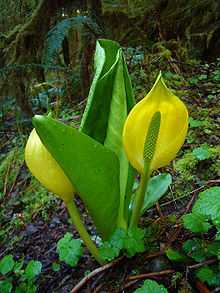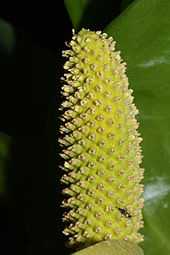Lysichiton americanus
| Lysichiton americanus | |
|---|---|
 | |
| Scientific classification | |
| Kingdom: | Plantae |
| (unranked): | Angiosperms |
| (unranked): | Monocots |
| Order: | Alismatales |
| Family: | Araceae |
| Subfamily: | Orontioideae |
| Genus: | Lysichiton |
| Species: | L. americanus |
| Binomial name | |
| Lysichiton americanus Hultén & H.St.John | |
| Synonyms | |
| |
Lysichiton americanus, also called western skunk cabbage (USA), yellow skunk cabbage (UK),[1] or swamp lantern, is a plant found in swamps and wet woods, along streams and in other wet areas of the Pacific Northwest, where it is one of the few native species in the arum family. The plant is called skunk cabbage because of the distinctive "skunky" odor that it emits when it blooms. This odor will permeate the area where the plant grows, and can be detected even in old, dried specimens. The distinctive odor attracts its pollinators, scavenging flies and beetles. Although similarly named and with a similar smell, the plant is easy to distinguish from the Eastern Skunk Cabbage (Symplocarpus foetidus), another species in the arum family found in eastern North America.
Description

The plant grows from rhizomes that measure 30 cm or longer, and 2.5 to 5 cm in diameter. The leaves are the largest of any native plant in the region, 50–135 cm long and 30–80 cm wide when mature. Its flowers are produced in a spadix contained within a large, bright yellow or yellowish green spathe 30–40 cm tall; it is among the first flowers to appear in spring.[2] Unlike the genus Symplocarpus (which includes S. foetidus, the eastern skunk cabbage), the flowers of Lysichiton species do not produce heat,[3] although this is widely and incorrectly said to be the case.[4]
Range
L. americanus is found from Kodiak Island and Cook Inlet, Alaska south through British Columbia, Washington, Oregon, and Northern California as far south as Santa Cruz County. Isolated populations are also found in northeastern Washington, northern Idaho, Montana, and Wyoming.[5]
The plant was introduced into cultivation in the United Kingdom in 1901 and has escaped to become naturalized in marshy areas in Britain and Ireland, for example in Hampshire and Surrey, including Wisley Gardens, and in the north and west of the UK.[6]
Cultivation
It has been used as an ornamental garden plant in Britain and Ireland, where it grows well in marshy conditions. It has gained the Royal Horticultural Society's Award of Garden Merit.[7]
Hybrids with Lysichiton camtschatcense, called Lysichiton × hortensis, are also cultivated. These have larger spathes than either of the parents.[6]
Other uses
While some consider the plant to be a weed, its roots are food for bears, who eat it after hibernating as a laxative or cathartic. The plant was used by indigenous people as medicine for burns and injuries, and for food in times of famine, when almost all parts were eaten. The leaves have a somewhat spicy or peppery taste. Caution should be used in attempts to prepare western skunk cabbage for consumption, as it contains calcium oxalate crystals, which result in a gruesome prickling sensation on the tongue and throat and can result in intestinal irritation and even death if consumed in large quantities. Although the plant was not typically part of the diet under normal conditions, its large, waxy leaves were important to food preparation and storage. They were commonly used to line berry baskets and to wrap around whole salmon and other foods when baked under a fire. It is also used to cure sores and swelling.
See also

- Asian Skunk Cabbage: A related plant (in the genus Lysichiton) from north-east Asia, but not known for producing a foul smell.
- Eastern Skunk Cabbage: Although not in the same genus (Symplocarpus foetidus), it is often confused with Western Skunk Cabbage
- Bog Arum: A similar plant grown as an ornamental herbaceous perennial.
References
- ↑ RHS A-Z encyclopedia of garden plants. United Kingdom: Dorling Kindersley. 2008. p. 1136. ISBN 1405332964.
- ↑ "Lysichiton americanus". Learn 2 Grow. Retrieved 2012-12-04.
- ↑ Onda, Yoshihiko; Kato, Yoshiaki; Yukie, Abe; Ito, Takanori; Morohashi, Miyuki; Ito, Yuka; Ichikawa, Megumi; Matsukawa, Kazushige; Kakizaki, Yusuke; Koiwa, Hiroyuki; Ito, Kikukatsu (2008). "Functional Coexpression of the Mitochondrial Alternative Oxidase and Uncoupling Protein Underlies Thermoregulation in the Thermogenic Florets of Skunk Cabbage". Plant Physiology 146 (2). pp. 636–645. doi:10.1104/pp.107.113563.
- ↑ See as one example "Lysichiton americanus". Learn 2 Grow. Retrieved 2012-12-04.
- ↑ USDA. "PLANTS Profile:Lysichiton americanus". Retrieved 2008-03-13.
- ↑ 6.0 6.1 Armitage, James D. & Phillips, Barry W. (2011), "A hybrid swamp lantern", The Plantsman (New Series) 10 (3): 155–157
- ↑ "RHS Plant Selector - Lysichiton americanus". Retrieved 22 May 2013.
External links
- Flora of North America: Lysichiton americanus
- Germplasm Resources Information Network: Lysichiton americanus
- Native American Ethnobotany: Lysichiton americanus
- UBC Botanical Garden and Centre for Plant Research: Lysichiton americanus
| Wikimedia Commons has media related to Lysichiton americanus. |